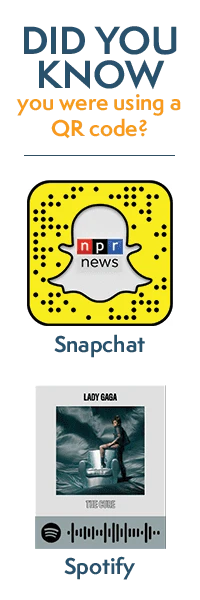You're Using QR Codes More Than You Realize
by Abrar Khandoker | Last Updated: Sep 14, 2017
by Abrar Khandoker | Last Updated: Sep 14, 2017
 While retailers continue to use QR codes to promote their brands, tech giants have also acknowledged QR’s presence. In step with Apple, Facebook’s Messenger app is already ahead of the curve by having opened the door to mass adoption of QR codes, as it already allows its 1.2 billion users to scan QR codes without ever leaving the app–making QR codes more accessible than ever.
Wait, That’s A QR Code?
As mobile devices and device usage continue to grow every day, the possible uses of QR codes are constantly growing as well. Millennials are using QR codes in their social lives, whether they know it or not. Snapchat provides "Snapcodes" for users to add other users to their networks or to access a brand's website, and Spotify enables users to share songs by simply scanning a code off of another user's screen. The codes have even worked their way into payment systems in multiple areas of the world. In India, both Visa and MasterCard allow shoppers to make purchases by scanning codes. Over the course of 2016, WeChat's payment system, WeChatPay, experienced a 93% usage of its QR-based payment method.
Corporations Are Catching On
Just as Visa, MasterCard, and WeChat have seen the potential of QR codes, other major retailers and brands believe that QR codes are here to stay. Disney uses QR codes to provide exclusive content within their games, while Jeep and Pepsi present Snapcodes to increase social engagement. Coca-Cola takes a different approach by offering a $1 discount on a customer's next Coke purchase each time they scan a QR code.
As the future looks to be full of the codes, tech giants and leading companies are aiming to capitalize on its newfound value. If you need more convincing before you join us in the QR code fan club, check out our infographic, 7 Reasons You Should Reconsider QR Codes.
While retailers continue to use QR codes to promote their brands, tech giants have also acknowledged QR’s presence. In step with Apple, Facebook’s Messenger app is already ahead of the curve by having opened the door to mass adoption of QR codes, as it already allows its 1.2 billion users to scan QR codes without ever leaving the app–making QR codes more accessible than ever.
Wait, That’s A QR Code?
As mobile devices and device usage continue to grow every day, the possible uses of QR codes are constantly growing as well. Millennials are using QR codes in their social lives, whether they know it or not. Snapchat provides "Snapcodes" for users to add other users to their networks or to access a brand's website, and Spotify enables users to share songs by simply scanning a code off of another user's screen. The codes have even worked their way into payment systems in multiple areas of the world. In India, both Visa and MasterCard allow shoppers to make purchases by scanning codes. Over the course of 2016, WeChat's payment system, WeChatPay, experienced a 93% usage of its QR-based payment method.
Corporations Are Catching On
Just as Visa, MasterCard, and WeChat have seen the potential of QR codes, other major retailers and brands believe that QR codes are here to stay. Disney uses QR codes to provide exclusive content within their games, while Jeep and Pepsi present Snapcodes to increase social engagement. Coca-Cola takes a different approach by offering a $1 discount on a customer's next Coke purchase each time they scan a QR code.
As the future looks to be full of the codes, tech giants and leading companies are aiming to capitalize on its newfound value. If you need more convincing before you join us in the QR code fan club, check out our infographic, 7 Reasons You Should Reconsider QR Codes.